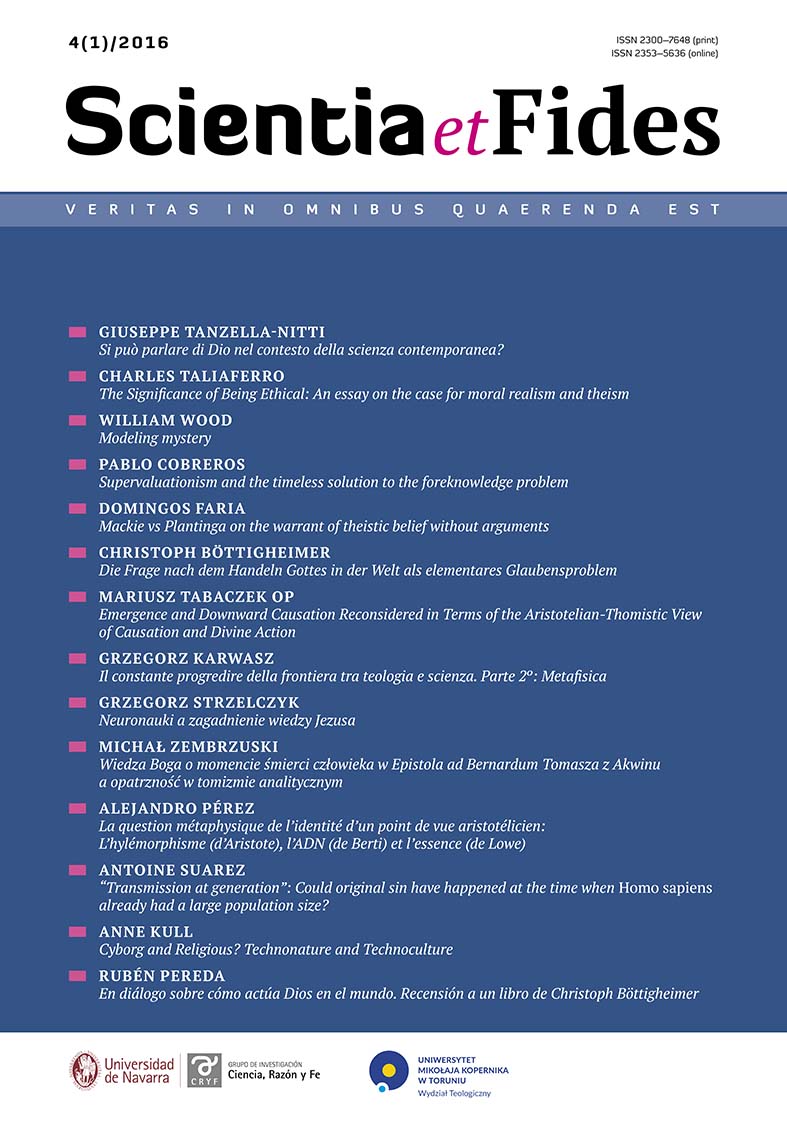Cyborg and Religious? Technonature and Technoculture
Słowa kluczowe
cyborg, symbol, technonature, challenges to theology and anthropology, Haraway, Tillich, PiccininiAbstrakt
We are all aware that our idea of natural/unnatural has been changing over the centuries. According to Donna Haraway, we must exit the maze of dualisms that has marred the relationships between human and non-human nature for centuries. Cyborg is a figure of speech and asymbol, but preeminently a description of our actual being in contemporary technonature. Her idea has been picked up by artists (e.g. Lynn Randolph, Patricia Piccinini) and philosophers and theologians. The cyborgian organism/human and the world cannot be articulated in terms of black-and-white, us and them, friend and foe, kin and alien, good and evil etc. Our technonatural creatures require our care and love, curiosity and investigation, and there will always be unexpected consequences.Bibliografia
Clark, Andy. 2003. Natural-Born Cyborgs: Minds, Technologies, and the Future of Human Intelligence. New York: Oxford University Press.
Downey, Gary Lee & Joseph Dumit. 1997. “Locating and Intervening. An Introduction.” In Cyborgs & Citadels. Anthropological Interventions in Emerging Sciences and Technologies, edited by Downey & Dumit. School of American Research Advanced Seminar Series (SAR). Santa Fe, New Mexico: School of American Research Press.
Elizondo, Virgilio. 2000. The Future is Mestizo: Life Where Cultures Meet. Boulder, CO: University Press of Colorado.
Gray, Chris Hables with the assistance of Heidi J. Figueroa-Sarriera & Steven Mentor (eds.). 1995. The Cyborg Handbook. New York & London: Routledge.
Gray, Chris H. 1996. “Medical Cyborgs: Artificial Organs and the Quest for the Posthuman.” In Technohistory, edited by Chris H. Gray. Malabar, FL: Krieger.
Haraway, Donna J. 1991. Simians, Cyborgs, and Women: The Reinvention of Nature. New York: Routledge.
“Interview with Donna Haraway. Participants: Randi Markussen, Finn Olesen, and Nina Lykke.” 2003. Chasing Technoscience: Matrix for Materiality, edited by Don Ihde and Evan Selinger, 47–57. Bloomington and Indianapolis: Indiana University Press.
Haraway, Donna J. 2007. “Speculative Fabulations for Technoculture’s Generations. (tender) creature exhibition catalogue. Artium. http://www.patriciapiccinini.net/essays/ [Accessed last 11 July 2013].
Haraway, Donna J. 2008. When Species Meet. Posthumanities, Volume 3. Minneapolis, London: University of Minnesota Press.
Hayles, Katherine N. 1999. How We Became Posthuman: Virtual Bodies in Cybernetics, Literature, and Informatics. Chicago: University of Chicago Press.
Kull, Anne. 2001. “Cyborg Embodyment and the Incarnation.” Currents in Theology and Mission, Vol. 28: 279–285.
Shults, LeRon F. 2003. Reforming Theological Anthropology: After the Philosophical Turn to Relationality. Grand Rapids, Michigan/ Cambridge, U.K.: William B. Eerdmans Eerdmans Publishing.
Thweatt-Bates, Jeanine. 2012. Ashgate Science and Religion Series: Cyborg Selves: A Theological Anthropology of the Posthuman. London and New York: Ashgate Publishing.
Tillich, Paul. 1957. Dynamics of Faith. New York: Harper and Row.
Tillich, Paul. 1966. On the Boundary. An Autobiographical Sketch. New York: Charles Scribner’s Sons.
Wildman, Wesley J. 2010. „Distributed Identity: Human Beings as Walking, Thinking Ecologies in the Microbial World.“ In Human Identity at the Intersection of Science, Technology and Religion, Ashgate Science and Religion Series, edited by Nancey Murphy and Christopher C., 165–178. Burlington, VT: Ashgate Publishing Company.
Pobrania
Opublikowane
Jak cytować
Numer
Dział
Licencja
CC BY ND 4.0. Posiadaczem prawa autorskiego (Licencjodawcą) jest Autor, który na mocy umowy licencyjnej udziela nieodpłatnie prawa do eksploatacji dzieła na polach wskazanych w umowie.
- Licencjodawca udziela Licencjobiorcy licencji niewyłącznej na korzystanie z Utworu/przedmiotu prawa pokrewnego w następujących polach eksploatacji: a) utrwalanie Utworu/przedmiotu prawa pokrewnego; b) reprodukowanie (zwielokrotnienie) Utworu/przedmiotu prawa pokrewnego drukiem i techniką cyfrową (e-book, audiobook); c) wprowadzania do obrotu egzemplarzy zwielokrotnionego Utworu/przedmiotu prawa pokrewnego; d) wprowadzenie Utworu/przedmiotu prawa pokrewnego do pamięci komputera; e) rozpowszechnianie utworu w wersji elektronicznej w formule open access na licencji Creative Commons (CC BY-ND 3.0) poprzez platformę cyfrową Wydawnictwa Naukowego UMK oraz repozytorium UMK.
- Korzystanie przez Licencjobiorcę z utrwalonego Utworu ww. polach nie jest ograniczone czasowo ilościowo i terytorialnie.
- Licencjodawca udziela Licencjobiorcy licencji do Utworu/przedmiotu prawa pokrewnego nieodpłatnie na czas nieokreślony
PEŁEN TEKST UMOWY LICENCYJNEJ >>
Statystyki
Liczba wyświetleń i pobrań: 1253
Liczba cytowań: 5



